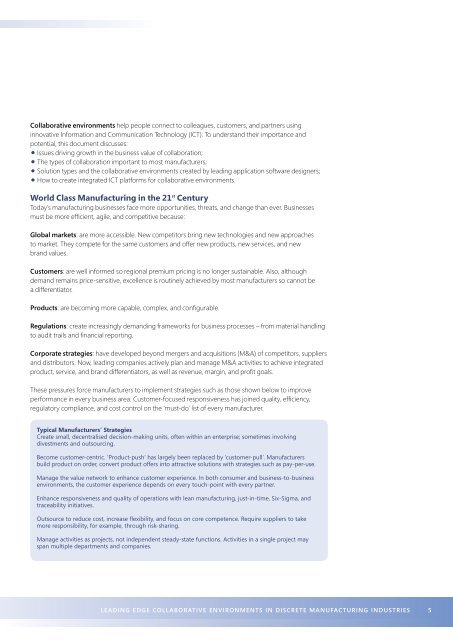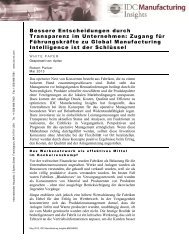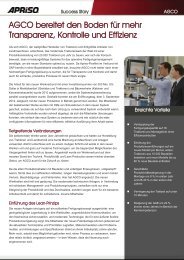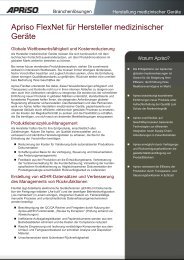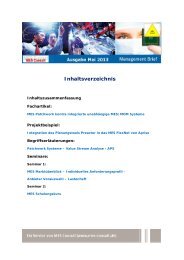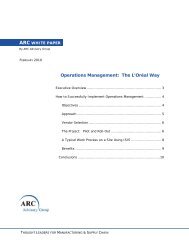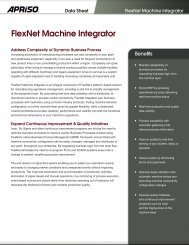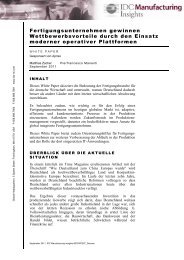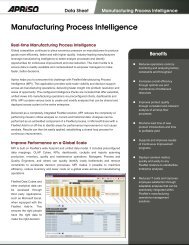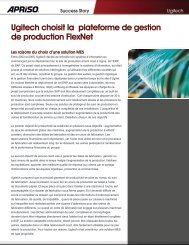Collaboration - Apriso
Collaboration - Apriso
Collaboration - Apriso
Create successful ePaper yourself
Turn your PDF publications into a flip-book with our unique Google optimized e-Paper software.
Collaborative environments help people connect to colleagues, customers, and partners using<br />
innovative Information and Communication Technology (ICT). To understand their importance and<br />
potential, this document discusses:<br />
• Issues driving growth in the business value of collaboration;<br />
• The types of collaboration important to most manufacturers;<br />
• Solution types and the collaborative environments created by leading application software designers;<br />
How to create integrated ICT platforms for collaborative environments.<br />
•<br />
World Class Manufacturing in the 21 st Century<br />
Today’s manufacturing businesses face more opportunities, threats, and change than ever. Businesses<br />
must be more efficient, agile, and competitive because:<br />
Global markets: are more accessible. New competitors bring new technologies and new approaches<br />
to market. They compete for the same customers and offer new products, new services, and new<br />
brand values.<br />
Customers: are well informed so regional premium pricing is no longer sustainable. Also, although<br />
demand remains price-sensitive, excellence is routinely achieved by most manufacturers so cannot be<br />
a differentiator.<br />
Products: are becoming more capable, complex, and configurable.<br />
Regulations: create increasingly demanding frameworks for business processes – from material handling<br />
to audit trails and financial reporting.<br />
Corporate strategies: have developed beyond mergers and acquisitions (M&A) of competitors, suppliers<br />
and distributors. Now, leading companies actively plan and manage M&A activities to achieve integrated<br />
product, service, and brand differentiators, as well as revenue, margin, and profit goals.<br />
These pressures force manufacturers to implement strategies such as those shown below to improve<br />
performance in every business area. Customer-focused responsiveness has joined quality, efficiency,<br />
regulatory compliance, and cost control on the ‘must-do’ list of every manufacturer.<br />
Typical Manufacturers’ Strategies<br />
Create small, decentralised decision-making units, often within an enterprise; sometimes involving<br />
divestments and outsourcing.<br />
Become customer-centric. ‘Product-push’ has largely been replaced by ‘customer-pull’. Manufacturers<br />
build product on order, convert product offers into attractive solutions with strategies such as pay-per-use.<br />
Manage the value network to enhance customer experience. In both consumer and business-to-business<br />
environments, the customer experience depends on every touch-point with every partner.<br />
Enhance responsiveness and quality of operations with lean manufacturing, just-in-time, Six-Sigma, and<br />
traceability initiatives.<br />
Outsource to reduce cost, increase flexibility, and focus on core competence. Require suppliers to take<br />
more responsibility, for example, through risk-sharing.<br />
Manage activities as projects, not independent steady-state functions. Activities in a single project may<br />
span multiple departments and companies.<br />
LEADING EDGE COLL ABORATIVE ENVIRONMENTS IN DISCRETE MANUFACTURING INDUSTRIES<br />
5


